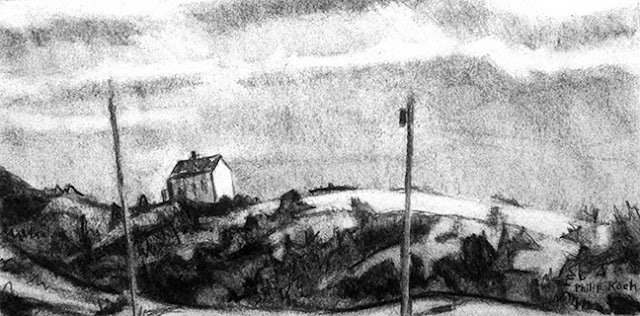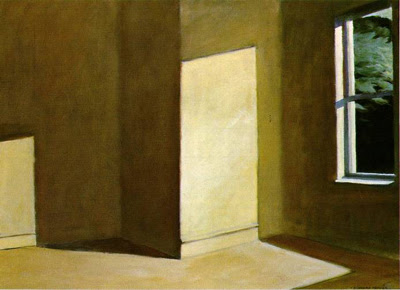More About Edward Hopper

Above is Monhegan Houses, Maine painted early on in Hopper's career around 1916-9. Monhegan was popularized as a great place to paint among artists largely through Hopper's charismatic teacher Robert Henri. Hopper was one of many who made voyages out to the little Maine island. His fellow Henri student, Rockwell Kent, liked Monhegan even better than Hopper and chose to stay and build a formidable studio there later owned by Jamie Wyeth, but that's another story.
Hopper did mostly small plein air oils while up there, and they rank among the very best paintings ever made of the island. This one's a view of the tiny village with Manana Island in the background. Nowadays lots of artists have painted similar views, though most lack Hopper's expressiveness.
One reason this oil has such power is Hopper's restraint. If you squint your eyes a bit when looking at it you immediately are struck by how Hopper segregated all his really light colors to just the very center of the canvas- the white house and a few boats in the harbor. Compare these to the much darker highlights in the foreground and in the distance. In real life there's almost no way such an arrangement is possible, yet Hopper makes it seem completely natural.
Probably 99 out of a hundred other artists standing in the same spot would have chosen to make Manana island in the distance one of the focal points of the painting. Hopper instead focuses on the geometry in the houses. Notice how he makes the little red chimneys dance around the roofs. And the way one of the diagonal roofs merges perfectly into the right hand diagonal side of the island in the background. This all shows Hopper kept looking a little longer than most other artists. Without that, one doesn't find the unexpected ideas to give one's viewers.
Above is an oil from later in Hopper's career. Titled Rooms for Tourists, it was painted up on Cape Cod from studies he made in Provincetown. Intriguingly, the same house is still there on Bradford Street and is still offering its rooms for rent as a Bed and Breakfast. It still looks substantially the same. Notice the wonderful detail of the odd shaped gap in the foreground hedge- if the artist hadn't included it and spotlighted it as he does the whole front of the painting would been too predictable. Another great touch is the way Hopper carves out a tangible space inside the house by using a warmer interior light than the cooler lights shining on the outside and on the hanging sign.
Gail Levin the art historian has written a great book documenting with her photographs the actual places Hopper used as sources for many of his paintings in her book Hopper's Places (you can get it from Amazon). I can't recommend it highly enough- she helps you tip toe into Hopper's mind as he selects, edits, alters, or down right lies about what he was looking at as he painted from a source.
And above is a painting Hopper did later in his career. He's pared down the room to its barest essentials. For Hopper that meant moving the viewers eye around the painting with his elegant and sharply focused shapes in the highlighted sunlight on the walls and floor. Just look at how he gradates the color from warm to cool in both highlights. This pushes your eye along and makes the emptiness feel meaningful and resonant.
I'm convinced the above painting was also inspired by his thirty years of living in his Cape Cod studio in S. Truro, MA. He kept it very sparsely furnished and would have seen light effects just like he painted above almost daily. When I've been up staying and working in his old studio I've been repeatedly struck how much the place reminds me of this painting.
Here's a photo of the Hopper's Truro studio overlooking Cape Cod Bay. Quite a place.





